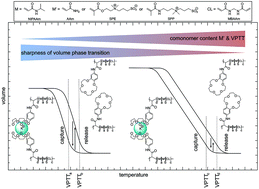Potassium-sensitive poly(N-isopropylacrylamide)-based hydrogels for sensor applications†
Abstract
Host–guest interactions for sensor applications have been widely applied to various platforms ranging from hard to soft nanoparticles or bulk materials. Their combination with stimuli-responsive polymers such as thermosensitive polymeric hydrogels allows for their potential applications in biomedical devices or even implants. Here, we present a systematic guideline to design high performance hydrogels for in vivo sensor applications. We report on the synthesis via in situ cross-linking copolymerization and characterization of poly(N-isopropylacrylamide)-based hydrogels with a tailored volume phase transition temperature (VPTT) by copolymerization with hydrophilic comonomers, namely uncharged acrylamide, and zwitterionic N-(3-sulfopropyl)-N-(methacryloxyethyl)-N,N-(dimethyl)ammonium betaine and N,N-dimethyl-N-(2-methacrylamidopropyl)-N-(3-sulfopropyl)ammonium betaine. Moreover, these hydrogels are able to recognize potassium through the incorporation of 4-acryloylamidobenzo-15-crown-5 as a host comonomer in the network. Along with the thorough investigation of the VPTT of the hydrogels by differential scanning calorimetry and swelling experiments, a novel methodology was developed for a fast and easy assessment of the VPTT of hydrogels’ in the case that this kind of transition changes from the 1st to 2nd order. Thus, comonomers were evaluated regarding their ability to shift the VPTT of the hydrogels combined with a maximum volume change upon temperature change. The impact of total monomer concentration, crown ether content and imprinting with potassium ions during synthesis on the material performance was addressed as well. Potassium recognition and cross-sensitivity against sodium were investigated exemplarily for acrylamide-containing hydrogels under physiologically relevant conditions. Materials which have fine potassium sensing performances for physiologically relevant ion concentrations (around 5 mM potassium) were identified and exhibit low cross-sensitivities for sodium ions (around 125 mM). By the incorporation of hydrophilic monomers, the VPTT could successfully be shifted and therefore allows accurate determination of the potassium ion concentration also at physiologically relevant temperatures (37 to 39 °C). To the best of our knowledge, this is the first system that allows the determination of low potassium ion concentrations under physiologically relevant conditions. Thus, these materials enable future biosensor or implant applications for patients with, e.g., hyperkalemia.



 Please wait while we load your content...
Please wait while we load your content...